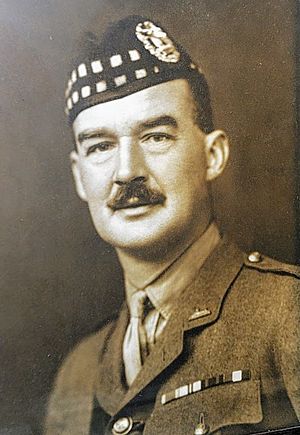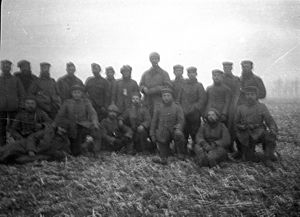John Raymond Evelyn Stansfeld facts for kids
Quick facts for kids
John Raymond Evelyn Stansfeld
DSO
|
|
|---|---|
 |
|
| Born | 20 April 1880 |
| Died | 28 September 1915 (aged 35) |
| Nationality | British |
| Occupation | Soldier |
| Spouse(s) | Constance Yolande de Bourbel de Montpincon |
| Relatives | William Crompton-Stansfield Sir James Stansfeld James Rawdon Stansfeld Thomas Wolryche Stansfeld |
| Military career | |
| Allegiance | |
| Service/ |
|
| Years of service | 1899–1915 |
| Rank | 2nd Lieutenant (1899) Lieutenant (1900) Captain (1904) Major (1915) Lieutenant-Colonel (1915) |
| Unit | 2nd Gordon Highlanders |
John Raymond Evelyn Stansfeld (born April 20, 1880 – died September 28, 1915) was a brave British army officer. He fought in important battles during the Second Boer War and World War I. He was part of the famous Gordon Highlanders regiment.
Stansfeld was known for his courage. He helped wounded soldiers and was honored for his actions. Sadly, he died fighting for his country during World War I at the Battle of Loos.
Contents
John Stansfeld's Early Life
John Stansfeld was born on April 20, 1880. He was the youngest child and only son of John Birkbeck Evelyn Stansfeld. His father was a church leader in Preston, England.
John went to Uppingham School. He was a very talented athlete there. In 1896, he won the school's boxing competition. People at his school thought he had a lot of promise in sports.
His Military Career Begins
After school, John Stansfeld joined the Royal Military Academy Sandhurst in 1898. This was a special school for training army officers. He continued to show his athletic skills there. He won the heavyweight boxing championship. He also led the football team.
In June 1899, he graduated from Sandhurst. He was even awarded the Sword of Honour. This award is given to the best cadet. Just four months later, he joined the 2nd Battalion, Gordon Highlanders. He was sent straight to the Second Boer War in South Africa.
Fighting in the Boer War
John Stansfeld served in the Second Boer War from 1899 to 1902. He took part in several key battles. These included the Relief of Ladysmith and the Battle of Spion Kop.
At the Battle of Spion Kop, he showed great bravery. He helped injured soldiers even while under enemy fire. For his courage, he received the Distinguished Service Order (DSO) in 1900. He was also mentioned in official reports twice for his actions. He received two special medals for his service in this war.
After the Boer War, Stansfeld served in India and Egypt. He returned to Europe in 1914.
World War I Service

When World War I began, John Stansfeld was sent to Belgium. He was wounded during the First Battle of Ypres. After recovering for three weeks, he returned to the front lines. He was again recognized for his bravery.
One amazing event he was part of was the Christmas truce in 1914. During this truce, soldiers from opposing sides stopped fighting on Christmas Day. They even met in no-man's-land. Stansfeld wrote a letter to his wife about this special day:
This letter will reach you about New Year's Day. I must describe my Xmas day to you, which was most unique, and very interesting. Sprot and I were alone, we went to Communion Service at 8am in a hay-loft! There were about 40 people, mostly officers. The General, and all his staff, and a lot of gunners were there. Most of the officers of course were in the trenches. We returned to breakfast, and had the Xmas tree on the table, and with that coffee, quaker oats and eggs and bacon, and ration jam (a curious mixture of tea-leaves and turnips). We thoroughly enjoyed ourselves.
...
When Sprot and I arrived (about 3pm) there was no-one in the ... of our section, so I waved for one of the Germans to come across and talk, which he did. We met in the middle but beyond shaking hands and laughing at one another, we could not say very much as we were both ignorant of the other's language. Henry (big drummer) who is my orderly with Piper Stuart was with us and I had carefully left my camera in our trenches in case of raising suspicion, but as my friend seemed quite willing to be photographed, I sent Henry for it. Meanwhile in order to collect a few men for the group, I gave couple of View Halloos. Effect marvellous. Heads popped up everywhere. They thought we were charging them, I think!! When they saw what was happening, about 20 came across.
I took 2 photos with Sprot in the group, and he took 2 with me in the group. It should be most interesting and quite unique. I should get into awful trouble if it was known, as we are not allowed to take photos. But what a chance to have missed. They were Bavarians and Hanoverians, 15th, 115th and 158th Regiments. They were very cheery and laughed at nothing, in fact merriment was rather forced on both sides. However, we ragged one another. There was one measly looking officer, who looked as if he played a tin whistle in civil life. One man made a horrible face and slunk off like a frightened wolf – and started to run to his trench. I honestly thought he was going to get his gun and shoot me. So Sprot and I walked quietly back to our trench, ready to jump in, if there was any trouble. Presently he came back with four pals and shouted to me to go back and photograph them as well! I did not go back. As the Boer prisoner said to me at Jopa "he looked me false in ze face".
Stansfeld was promoted to Major and then to Lieutenant Colonel.

In March 1915, at the Battle of Neuve Chapelle, he was wounded again. A piece of shrapnel hit his shoulder. He recovered and soon returned to lead his troops.
Death at the Battle of Loos
John Stansfeld commanded the 2nd Gordons at the Battle of Loos. This battle began on September 25, 1915. Within minutes of the battle starting, Stansfeld was severely wounded in both legs. He was taken away for medical help, and his right leg had to be amputated.
Sadly, he died from his wounds three days later, on September 28, 1915. He passed away at a field hospital in Chocques, France. Lieutenant-Colonel Stansfeld was one of many British commanding officers who were killed or wounded in that battle.
Remembering John Stansfeld
A special memorial service was held for Lieutenant-Colonel Stansfeld in October 1915. It took place at St. Mary's Church in Montrose, Scotland. Many people attended, including officers and wounded soldiers from his regiment.
Lieutenant-Colonel Stansfeld is buried at the Chocques Military Cemetery in France. He is also honored at The Royal Memorial Chapel, Sandhurst in England. A plaque in his memory is also at Craig Parish Church.
His Family
In 1904, John Stansfeld married Constance Yolonde de Bourbel de Montpincon. They had one son, Captain John de Bourbel Stansfeld. Their son also served in the military and received the Military Cross.

